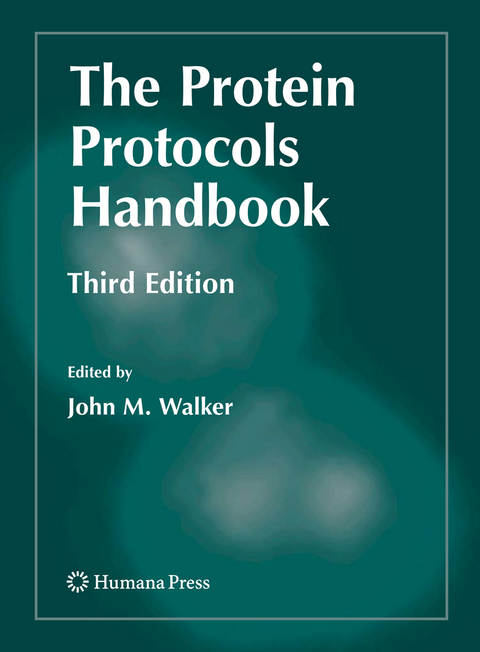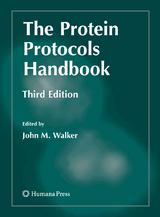The Protein Protocols Handbook
Humana Press Inc. (Verlag)
978-1-60327-474-6 (ISBN)
Since the publication of the bestselling second edition of John Walker’s widely acclaimed Protein Protocols Handbook, there have been continual methodological developments in the field of protein chemistry. This greatly enhanced third edition introduces 57 critically important new chapters, as well as significantly updating the previous edition's tried-and-true methods. Although the timely new chapters are spread throughout all of the book, the vital section on post-translational modifications has been expanded most to reflect the increasing importance of these modifications in the understanding of protein function.
Each readily reproducible method follows the highly praised format of the Methods in Molecular Biology™ series, offering a concise summary of its basic theory, a complete materials list, a step-by-step protocol for its successful execution, and extensive notes on avoiding pitfalls, or on modifying the method to function within your own experimental circumstances. The expert authors of each chapter have demonstrated a hands-on mastery of the methods described, fine-tuned here for optimal productivity.
Comprehensive, cutting-edge, and highly practical, The Protein Protocols Handbook, Third Edition is today's indispensable benchtop manual and guide, not only for all those new to the protein chemistry laboratory, but also for those established workers seeking to broaden their armamentarium of techniques in the urgent search for rapid and robust results
Protein Determination by UV Absorption.- The Lowry Method for Protein Quantitation.- The Bicinchoninic Acid (BCA) Assay for Protein Quantitation.- The Bradford Method for Protein Quantitation.- Ultrafast Protein Determinations Using Microwave Enhancement.- The Nitric Acid Methods for Protein Estimation in Biological Samples.- Quantitation of Tryptophan in Proteins.- Kinetic Silver Staining of Proteins.- Quantitation of cellular proteins by flow cytometry.- Quantitation of cellular proteins by laser scanning cytometry.- Protein Solubility in 2D Electrophoresis: Basic principles and issues.- Mouse and Human Tissues Sample Preparation for 2-D Electrophoresis.- Plant Protein sample preparation for 2DE.- Preparation of bacterial samples for 2-D PAGE.- Preparation of bodily fluids for 2-D PAGE.- Immunoaffinity Depletion of high abundance plasma and serum proteins.- Preparation of Yeast samples for 2D PAGE.- Membrane Protein Preparation Using Aqueous Polymer Two Phase Systems.- Subcellular fractionation of small sample amounts.- Nondenaturing Polyacrylamide Gel Electrophoresis of Proteins.- SDS Polyacrylamide Gel Electrophoresis of Proteins.- Gradient SDS Polyacrylamide Gel Electrophoresis of Proteins.- SDS-Polyacrylamide Gel Electrophoresis of Peptides.- Blue native gel electrophoresis (BN-PAGE).- Separation of proteins by gel electrophoresis in the Tris-Taurine-HCl system.- Cetyltrimethylammonium Bromide Discontinuous Gel Electrophoresis of Proteins: M -Based Separation of Proteins with Retained Native Activity.- Acetic Acid-Urea Polyacrylamide Gel Electrophoresis of Basic Proteins.- Acid-Urea-Triton Polyacrylamide Gel Electrophoresis of Histones.- Isoelectric Focusing of Proteins in Ultra-Thin Polyacrylamide Gels.- Serial immobilized pH gradient isoelectric focusing over pH 4-9.- Radiolabelling of Eukaryotic Cells and Subsequent Preparation for 2-D.- Two-Dimensional PAGE Using Carrier Ampholyte pH Gradients in the First Dimension.- Vertical agarose electrophoresis and electroblotting of high molecular weight proteins.- 2D PAGE of high molecular weight proteins.- Casting immobilised pH gradients.- Nonequilibrium pH Gel Electrophoresis.- Microchip capillary electrophoresis.- Protein Separations in Microfluidic Chips.- Difference gel electrophoresis (DIGE).- Comparing 2-D Electrophoresis Gels Across Internet Databases.- Quantification of Radiolabeled Proteins in Polyacrylamide Gels 25.4.07.- Differential ProteoTope radioactive quantification of protein abundance ratios.- Quantitation of Proteins on Polyacrylamide Gels.- Using SDS-PAGE and scanning laser densitometry to measure proteins.- Rapid and Sensitive Staining of Unfixed Proteins in Polyacrylamide Gels with Nile Red.- Zinc reverse staining technique.- Protein Staining with Calconcarboxylic Acid in Polyacrylamide Gels.- Detection of Proteins in Polyacrylamide Gels by Silver Staining.- Background-free Protein Detection on Polyacrylamide Gels and on Electroblots Using Transition Metal Chelate Stains.- Detection of Proteins in Polyacrylamide Gels by Fluorescent Staining.- Detection of Glycoproteins in Gels and Blots.- Staining of Glycoproteins/Proteoglycans on SDS-Gels.- Detection of Proteins and Sialoglycoproteins in Polyacrylamide Gels Using Eosin X stain.- Pro-Q Diamond phosphoprotein staining.- Electroelution of Proteins from Polyacrylamide Gels.- Autoradiography and Fluorography of Acrylamide Gels.- Proteolytic Activity Detection by Two-Dimensional Zymography.- Protein Blotting by Electroblotting.- Protein Blotting by the Semi-dry Method.- Protein Blotting by the Capillary Method.- Western Blotting of basic proteins electrophoretically resolved on acid-urea-Triton-polyacrylamide gels.- Immunoblotting of 2-DE Separated Proteins.- High efficiency blotting of high-molecular weight proteins.- Alkaline Phosphatase Labeling of IgG Antibody.- b-Galactosidase Labeling of IgG Antibody.- Horseradish Peroxidase Labeling of IgG Antibody.- Digoxigenin (DIG) Labelling of IgG Antibody.- Conjugation of fluorochromes to antibodies.- Coupling of Antibodies with Biotin.- Preparation of Avidin Conjugates.- MDPF Staining of Proteins on Western Blots.- Copper Iodided Staining of Proteins and its silver enhancement.- Detection of Proteins on Blots using Direct Blue 71.- Detection of proteins on Western blots using colorimetric and radiometric vusialization of Secondary Ligands.- Identification of Glycoproteins on Nitrocellulose Membranes Using Lectin Blotting.- A Sensitive Method to Quantitatively Detect Total Protein on Membranes after Electrophoretic Transfer Using Avidin- or Streptavidin-Biotin.- Detection and Quantification of Proteins on Immunoblots using Enhanced Chemiluminescence.- Reutilization of Western Blots After Chemiluminescent Detection or Autoradiography.- The use of quantum dot luminescent probes for Western blot analysis.- The use of infrared fluorescent dyes in quantitative immunoblotting.- The use of infrared fluorescent dyes in immunofluorescence microscopy.- Carboxymethylation of Cysteine Using Iodoacetamide/Iodoacetic Acid.- Performic Acid Oxidation.- Succinylation of Protein.- Pyridylethylation of Cysteine Residues.- Side-Chain Selective Chemical Modifications of Proteins.- Nitration of Tyrosines.- Ethoxyformylation of Histidine.- Modification of Arginine Side Chains with p-Hydroxyphenylglyoxal.- Amidination of Carboxyl Groups.- Amidination of Lysine Side Chains.- Modification of tryptophan with 2-Hydroxy-5-Nitrogenzylbromide.- Modification of Sulhydryl Groups with DTNB.- Chemical Cleavage of Proteins at Methionyl-X Peptide Bonds.- Chemical Cleavage of Proteins at Tryptophanyl-X Peptide Bonds.- Chemical Cleavage of Proteins at Aspartyl-X Peptide Bonds.- Chemical Cleavage of Proteins at Cysteinyl-X Peptide Bonds.- Chemical Cleavage of Proteins at Asparaginyl-Glycyl Peptide Bonds.- Enzymatic Digestion of Proteins in Solution and in SDS Polyacrylamide Gels.- On-PVDF protein digestions for N-terminal sequencing and peptide mass fingerprinting.- Enzymatic Digestion of Proteins on PVDF membranes.- Reverse Phase HPLC Separation of Enzymatic Digests of Proteins.- Peptide Mapping by Two-Dimensional Thin-Layer Electrophoresis-Thin-Layer Chromatography.- Peptide Mapping by Sodium Dodecyl Sulfate-Polyacrylamide Gel Electrophoresis.- Peptide Mapping by High-Performance Liquid Chromatography.- Production of Protein Hydrolysates Using Enzymes.- Amino Acid Analysis by Precolumn Derivatization with 1- Fluoro-2,4-Dinitrophenyl-5-L-Alanine Amide (Marfey’s Reagent).- Amino acid analysis in protein hydrolysates using anion exchange chromatography and IPAD detection.- Validation of amino acid analysis.- Molecular Weight Estimation for Native Proteins Using High-Performance Size Exclusion Chromatography.- Detection of Disulfide-Linked Peptides by HPLC.- Detection of Disulfide-Linked Peptides by Mass Spectrometry.- Diagonal Electrophoresis for Detecting Disulfide Bridges.- Estimation of Disulfide Bonds Using Ellman’s Reagent.- Quantitation of Cysteine Residues and Disulfide Bonds by Electrophoresis.- N-Terminal sequencing of the N-terminally Modified Proteins.- De-blocking of Proteins containing N-Terminal Pyroglutamic Acid.- Detection and characterization of protein mutations by mass spectrometry.- Peptide Sequencing by Nanoelectrospray Tandem Mass Spectrometry.- Protein identification by Peptide mass fingerprinting using MALDI-TOFF Mass spectrometry.- Protein ladder sequencing.- Sequence Analysis with WinGene/WinPep.- HPLC and MS of integral membrane proteins.- Enrichment of Serum Peptides and Analysis by MALDI-TOF Mass Spectrometry.- Computational Methods for the Analysis of MALDI-TOF Spectra to Discover Peptide Serum Biomarkers.- Simple tools for complex N-glycan analysis.- A Lectin-Binding Assay for the Rapid Characterization of the Glycosylation of Purified Gycoproteins.- Chemical Methods of Analysis of Glycoproteins.- Monosaccharide Analysis by HPAEC.- Monosaccharide Analysis by GC.- Determination ofmonosaccharide linkage and Substitution Patterns by GC.MS Methylation Analysis.- Sialic Acid Analysis by HPAEC-PAD.- Chemical Release of O-Linked Oligosaccharide Chains.- O-Linked Oligosaccharide Profiling by HPLC.- O-Linked Oligosaccharide Profiling by HPAEC-PAD.- Release of N-Linked Oligosaccharide Chains by Hydrazinolysis.- Enzymatic Release of O- and N-Linked Oligosaccharide Chains.- N-Linked Oligosaccharide Profiling by HPLC on Porous Graphitized Carbon (PGC).- N-linked Oligosaccharide Profiling by HPAEC-PAD.- HPAE-PAD analysis of monosaccharides released by exoglycosidase digestion.- Microassay Analyses of Protein Glycosylation.- Polyacrylamide gel electrophoresis of fluorophore-labeled carbohydrates from glycoproteins.- HPLC Analysis of fluorescently labelled glycans.- Glycoprofiling purified glycoproteins using Surface Plasmon Resonance.- Sequencing Heparan Sulphate Saccharides.- Analysis of glycoprotein heterogeneity by Capillary Electrophoresis and Mass Spectrometry.- Affinity chromatography of oligosaccharides and glycopeptides with immobilized lectins.- In-Gel Enzymatic Release of N-glycans.- Analysis of N-Linked glycans by mass spectrometry.- MS Analysis of Protein glycosylation.- Mapping protein N-glycosylation by COFRADIC.- Mass spectrometric analysis of O-linked glycans released directly from Glycoproteins in gels using ß-elimination.- Glycopeptide analysis using LC/MS and LC/MSn.- Identification of Vitamin K-Dependent Proteins Using a Gla-specific Monoclonal Antibody.- The identification of protein S-Nitrocysteine.- Detection of nitrotyrosine-containing proteins.- Mass spectrometric determination of protein Ubiquitination.- Detection of Sumoylated Proteins.- Efficient enrichment of intact phosphorylated proteins by modified immobilized metal-affinity chromatography.- Analyzing Protein Phosphorylation.- Mass spectrometric analysis of protein phosphorylation.- Protein microarrays for phosphorylation studies.- TwoDimensional Phosphopeptide Mapping.- Identification of Proteins Modified by Protein (D-Aspartyl/L-Isoaspartyl) Carboxyl Methyltransferase.- Analysis of Tyrosine-o- sulfation.- Analysis of Protein Palmitoylation by metabolic radiolabeling methods.- Incorporation of radiolabeled prenyl alcohols and their analogs into mammalian cell proteins: a useful tool for studying protein prenylation.- Labelling and analysis of isoprenylated proteins in cells.- Antibody Production.- Production of Antibodies Using Proteins in Gel Bands.- Raising Highly Specific Polyclonal Antibodies Using Biocompatible Support Bound Antigens.- Production of antisera using peptide conjugates.- Small-molecule protein conjugation procedures.- The Chloramine T Method for Radiolabeling Protein.- The Lactoperoxidase Method for Radiolabeling Protein.- The Bolton and Hunter Method for Radiolabeling Protein.- Preparation of 125I-labelled peptides and proteins with high specific activity using iodogen.- Purification and Assessment of Quality of Radioiodinated Protein.- Purification of IgG by Precipitation with Sodium Sulfate or Ammoniun Sulfate.- Purification of IgG Using Caprylic Acid.- Purification of IgG Using DEAE-Sepharose Chromatography.- Purification of IgG Using Ion-Exchange HPLC.- Purification of IgG by Precipitation with Polyethylene Glycol (PEG).- Purification of IgG Using Protein A or Protein G.- Purification of IgG Using Size Exclusion High Performance Liquid Chromatography (SE-HPLC).- Purification of IgG Using Affinity Chromatography on Antigen-Ligand Columns.- Purification of IgG Using Thiophilic Chromatography.- Analysis of IgG Fractions by Electrophoresis.- Purification of Immunoglobulin Y (IgY) from Chicken Eggs.- Affinity Purification of Immunoglobulins Using PAM (Protein A Mimetic).- Detection of Serological Cross Reactions by Western Cross Blotting.- Enzymatic Digestion of Monoclonal Antibodies.- How to Make Bispecific Antibodies.- Antigen Measurements Using ELISA.- Enhancedchemiluminescence immunoassay.- Immunoprecipitation and Blotting.- Determination of Epitope by Mass Spectrometry.- Immunogen Preparation and Immunization Procedures for Rats and Mice.- Making Hybridomas.- Growing hybridomas.- Mouse Hybridomas as an Entryway to Monoclonal Antibody Design and Production.- Pitfalls.- Recombinant antibody expression and purification.- Screening Hybridoma Culture Supernatants Using Solid-Phase Radiobinding Assay.- Screening Hybridoma Culture Supernatants Using ELISA.- Growth and Purification of Murine Monoclonal Antibodies.- Affinity purification techniques for monoclonal antibodies.- A rapid method for generating large numbers of high-affinity monoclonal antibodies from a single mouse.
| Erscheint lt. Verlag | 7.10.2009 |
|---|---|
| Reihe/Serie | Springer Protocols Handbooks | Springer Protocols Handbooks |
| Zusatzinfo | LXX, 1984 p. In 2 volumes, not available separately. |
| Verlagsort | Totowa, NJ |
| Sprache | englisch |
| Maße | 182 x 260 mm |
| Themenwelt | Naturwissenschaften ► Biologie ► Biochemie |
| Naturwissenschaften ► Biologie ► Mikrobiologie / Immunologie | |
| Naturwissenschaften ► Biologie ► Zellbiologie | |
| ISBN-10 | 1-60327-474-X / 160327474X |
| ISBN-13 | 978-1-60327-474-6 / 9781603274746 |
| Zustand | Neuware |
| Haben Sie eine Frage zum Produkt? |
aus dem Bereich




